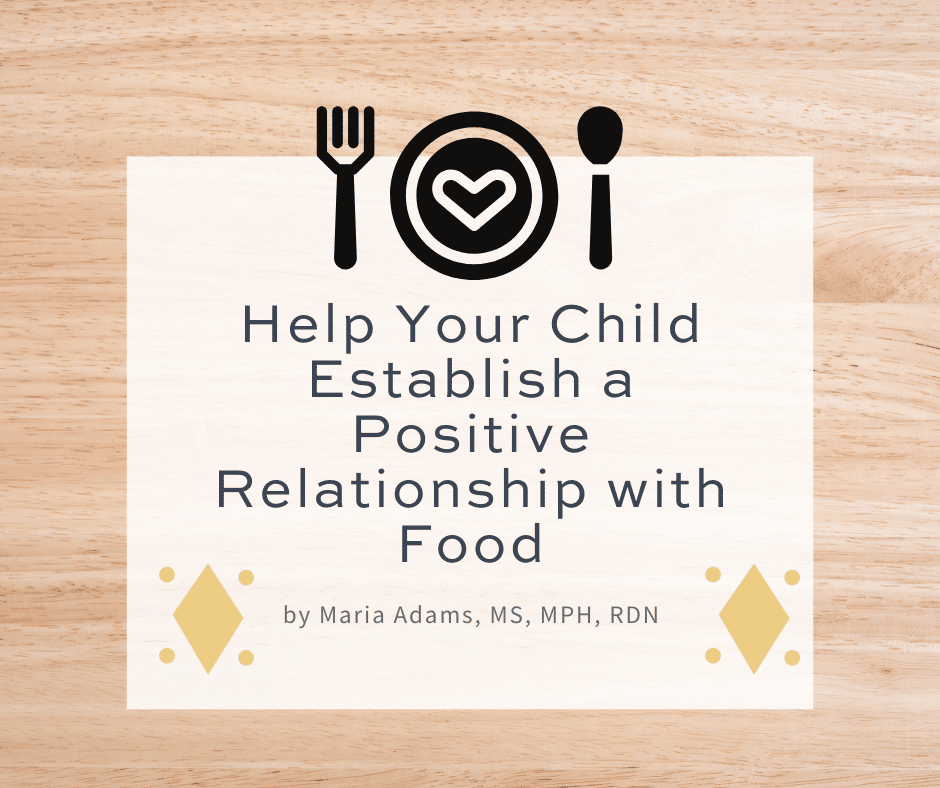
Help Your Child Establish a Positive Relationship with Food
A positive relationship with food is more important than “healthy” eating. Read on to learn more and get tips on how you can help your child establish a positive relationship with food.

This blog post is based on both my personal experience and research. I hope it serves as a helpful guide, but know that ultimately food and eating are very personal and you have to do what works for you and your family.
A Positive Relationship with Food
Parenting is filled with challenges, and like with anything we often learn by trial and error. Of course, even when we know what we should do, doing it isn’t always as easy. One thing that I have learned over the years is that when it comes to food and nutrition, helping our children establish a positive relationship with food is most important. In fact, it’s more important than teaching them about nutrition.
I didn’t realize this when I started the whole parenting journey almost 15 years ago. As a food-loving dietitian who was–and still is–passionate about promoting healthful eating, I was eager to teach my kids about nutrition. I wanted them to grow up being “healthy” eaters.
Fortunately, thanks to my work, personal experiences, and parenting resources, I learned a thing or two along the way. And I want to add that I’m still learning. I think this is such an important topic that I have compiled some of my top advice for promoting a positive relationship with food here.
Try Not to Label Foods
While I have always had the philosophy that all foods can fit, I used to talk about “healthy” vs. “unhealthy” foods–obviously with the same intentions as any well-meaning parent, to try and help my kids eat well and be healthy. Fortunately, I now recognize that this kind of labeling does more harm than good and will not help your child have a positive relationship with food. Read more about food language and labeling here.
Try Not to Comment on Eating at the Table
Another tactic that can do more harm than good: commenting on a child’s eating at the table. For example:
- Bribing, nagging, or pleading with your child to eat their food, or
- Commenting on how much they are or aren’t eating, or
- Asking them to clean their plate.
The first is likely to kids more likely to reinforce picky eating behaviors, and the second and third are likely to lead them away from their own eating intuition. To encourage a positive relationship with food, your best bet is to chat about topics unrelated to food. Read more about this in this post on the division of responsibility.
Skip the Diet Talk (and the Dieting)
While you can’t protect your kids from the diet culture that exists in our society, you can teach them to spot it and call it out. You can also help them be confident about their own body and eating habits. Whether it’s commenting on your body size, someone else’s body size, or the latest diet, your kids hear everything. Do your best to refrain from diet and body talk. Likewise, skip the diet or clean eating plan and instead work on nourishing your own body using an intuitive eating approach and without the rules of diet culture.
Encourage Independence in Tweens and Teens
It’s important to continue structured meals during adolescence, especially the family dinner. However, during this time your child is more likely to be independent with some meals and snacks. This independence is good, however, rather than leaving it totally up to them to choose their meals, you can still encourage nourishing options.
Your kids may still need support to make sure they get a good snack after school snack every day. Depending on how independent and motivated your child is about their snack this could mean anything from simply keeping nourishing options on hand for them to choose from to actually putting it out in front of them.
Often, the amount of help that is needed falls somewhere in the middle. For example, my 12-year-old is pretty good at recognizing that he is hungry and needs a snack, but will likely reach for easy-to-eat options such as pretzels, crackers, or peanuts. If I slice fruit or veggies up and put it in front of him he will eat it, but otherwise, there is a good chance he would skip the fruit or vegetable.
Looking for more help with fostering these habits in tweens and teens? Check out these great resources.
Foster Nourishing Habits
Don’t expect your child to choose balanced meals every time they sit down to eat, however, with your support, chances are it will start to become a habit and happen more often. But don’t beat yourself up if this is not happening, instead, try to get them involved by making their own snacks or making a list of the fruits and veggies that would love to have on hand.
In addition to this “gentle nutrition” approach, it’s important to help them develop mindful eating habits. Little actions such as asking them to sit down when they eat, savoring your food alongside them, and putting away screens during eating time can go a long way to helping promote these habits. These days, I feel like it’s harder than ever to get those phones away, but I do my best to role model this behavior!
You’ve Got This
There is a lot more I could say on this topic. However, this is a blog post and not a book! Know that there is no one right way to parent or help your child develop this positive, joyful relationship with food. Chances are you are doing a great job already, but if you feel like you could use a little extra support seek out a Registered Dietitian who specializes in family eating and takes an intuitive eating, non-diet approach. I’m currently taking on a small number of clients for one-on-one counseling.

Leave a Reply